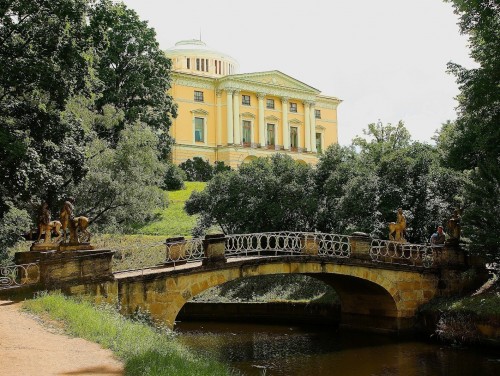The palace is the structural center of the Pavlovsk architectural and landscape ensemble. This is emphasized by the position of the palace: monumental and imposing building stands on a hill and could be easily seen from the remote corners of the park.
Construction works on the palace destined for Pavel Petrovitch (future emperor Paul I) and his wife Maria Fiodorovna began in May 1782. The architect Charles Cameron has taken charge of the construction. The palace is similar in appearance to an Italian villa, and its classical layout matches well with the Temple of Friendship and Apollo Colonnade, the park pavilions having been raised previously by the same architect.
Pavlovsk palace, unlike the Great Palace in Peterhof and Catherine Palace in Tsarskoe Selo which served for the state receptions and official ceremonies, was meant for family vacations.
Rooms and halls of the palace are exquisitely and tastefully decorated, but they share a common feature: low-key, almost intimate atmosphere, what is associated with classical trends dominated in the architecture and interior design in the second half of the XVIII century. Abundance of gilded details, and intricate ornamentation became a thing of the past.
The appearance of the palace changed in 1796, the year Paul I acceded to the throne. Designed by Cameron the palace was rebuild by V. Brenna, then a court architect. Brenna added a storey to the service wings, and attached two more buildings to the palace, but the central wing was left untouched. On the death of Paul I in 1801, his wife Maria Fiodorovna became a sole mistress of the residency till her death in 1828.
The palace interiors were redesigned at the first quarter of the XIX century by the architects A.N. Voronikhin and K.I. Rossi. Famous Gonzaga Gallery, named after its author, was completed in 1808. P. Gonzaga created seven fresco panels each of which features perspective drawing of an arch with ancient sculptures and vases, window openings and colonnades. The Gonzaga Gallery is completely restored by now, it overlooks the Slavyanka River, hence is well within view from the river side.
After the Revolution 1917 the estate was nationalized. During the Second World War Pavlovsk shared the same fate as the other suburban districts of Leningrad (the name of Saint Petersburg from 1924 till 1991) which were occupied from September 1941 till January 1944. The palace fell into ruin, but fortunately bulk of the collections and exhibits have been evacuated into the depth of the country thanks to efforts made by A.I. Zelenova, the then head of the museum. Significant restoration works have been done on the palace under the supervision of Zelenova during the period from 1944 to 1978.



